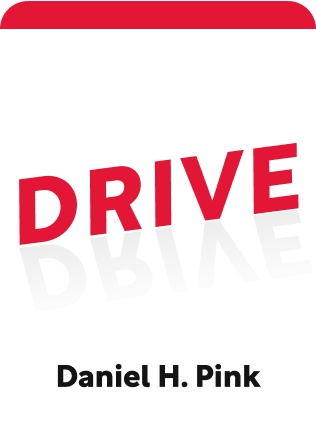

This article is an excerpt from the Shortform book guide to "Drive" by Daniel H. Pink. Shortform has the world's best summaries and analyses of books you should be reading.
Like this article? Sign up for a free trial here .
What is Daniel Pink’s motivation theory? Why is the reward-and-punishment motivation approach no longer effective?
In his book Drive: The Surprising Truth About What Motivates Us, Daniel Pink argues that in today’s complex society, the conventional, reward-and-punishment approach to motivation (what he calls Motivation 2.0) is no longer effective because the demands of work have shifted from rote to intelligent and creative. In this new world, companies need to identify people who are self-motivated, and they need to understand how to avoid crushing this spirit.
In this article, we’ll look at why Motivation 2.0 is limited in motivating the modern workforce, and how we can replace it.
Motivation 1.0
Much like computers, society is run by underlying operating systems – a set of protocols, laws, and understandings that govern how we view the world and how we behave with each other.
The earliest operating system, termed Motivation 1.0 in the book, was simple, biological: we are animals trying to survive, and satisfying the primal needs of food, water, shelter, and sex is a fundamental driving force. This kept the human species alive for much of our evolutionary past.
But when humans created more complex societies, Motivation 1.0 was inadequate. Satisfying primal urges would have encouraged theft, murder, and adultery. So common expectations of behavior were put into place to suppress Motivation 1.0. Humans transcended to organize around a second drive, Motivation 2.0: to seek reward and avoid punishment.
This worked especially well during industrialization in the 19th and 20th centuries. Because human work in factories was easy to measure, it was easy to see how work policies changed productivity. Pay people more per widget they make, and they’ll crank out more widgets.
Thus, the management approach in this period viewed workers as simple cogs in a machine – lubricate them appropriately with external rewards or punishments, and they will run smoothly to keep the overall machine humming. This is a relatively simple model to understand, monitor, and enforce. Motivation 2.0 enabled great efficiency of manual labor and assembly-line performance, which spurred much of the growth in the past 200 years.
But more recently, Motivation 2.0 has run into limitations itself. It fails to satisfyingly explain certain phenomena like:
- Wikipedia successfully thrives as a massive crowd volunteering effort – no contributors are paid for editing and adding material. In contrast, Microsoft Encarta, an encyclopedia from the 1990s, failed to keep up with the Internet despite massive financial investment.
- Imagine you were asked in that time to bet on which product would succeed: 1) a product made by the world’s largest software company, with an army of well-paid authors, or 2) an online community full of uncredentialed, unpaid volunteers. You wouldn’t be blamed for choosing the former.
- This example generalizes to open source projects like Linux and Apache, where contributors are driven strongly by unpaid motivations.
- New corporate structures that de-emphasize profit are emerging, like the “low-profit limited liability company” or the “B corporation,” both of which emphasize social good rather than profit maximization. This growing movement suggests that people aren’t driven entirely by financial rewards.
- People often leave lucrative jobs to take lower-paying ones that provide a clearer purpose or are more inherently enjoyable.
Note that extrinsic rewards are not totally absent from the examples above. For example, open-source contributors gain experience and resume line items that enhance earning potential later. But this isn’t a direct and immediate reward, so standard operant conditioning models don’t apply.
Recognizing Motivation 2.0’s limits are important because the nature of our work is changing from the rote to the creative. The assembly line-like jobs of the early 20th century are disappearing to outsourcing and automation. Today’s information work is basing more on critical thinking and creativity. And in this new economy, using tools that worked in the old economy can be harmful.
Understanding motivation is also important because companies are becoming less hierarchical, trimming manager levels and imposing less direct oversight over workers.
Motivation 2.0
The outdated Motivation 2.0 is based on two ideas:
- Rewarding an activity will get you more of it.
- Punishing an activity will get you less of it.
This “carrot and stick” model is still generally effective in the workplace. At a minimum, compensation serves as a “baseline reward” or a “hygiene factor” – if it’s not there, the worker cannot focus. She’ll obsess over how unfair her situation is and be anxious about her financial problems. So high enough financial rewards are necessary for a baseline of motivation.
According to Dan Pink, Motivation 2.0 is incomplete in explaining worker behavior. Even further, when it’s applied incorrectly, it can actually be counterproductive.
Motivation 3.0
So far, we’ve covered how the traditional reward/punishment system is limited in motivating today’s workers. But how do we replace Motivation 2.0?
Consider this thought experiment: would you rather be paid $75,000 to be an architect for the rest of your life, or $100,000 to be a toll booth operator for the rest of your life? If you choose the former, you’ve recognized that compensation isn’t everything. This idea is the basis for Dan Pink’s Motivation 3.0 system, which is focused on intrinsic rewards.

———End of Preview———
Like what you just read? Read the rest of the world's best book summary and analysis of Daniel H. Pink's "Drive" at Shortform .
Here's what you'll find in our full Drive summary :
- Why you may be feeling unmotivated and unsatisfied at work and in life
- Why financial rewards aren't enough to keep employees motivated anymore
- The three components of intrinsic motivation






